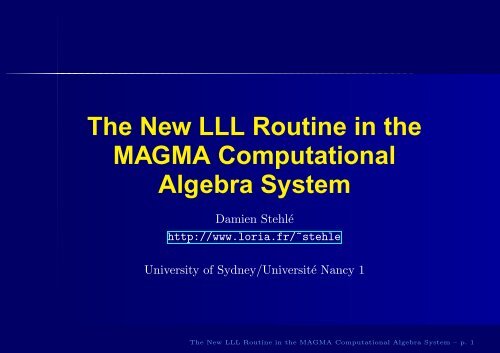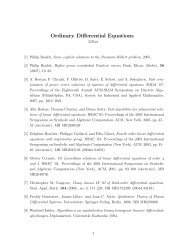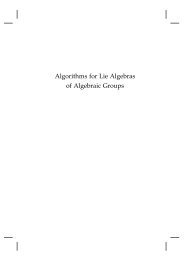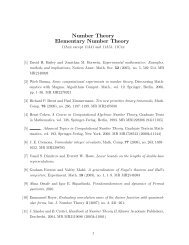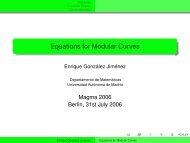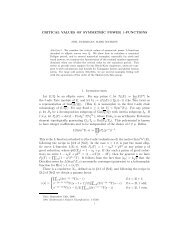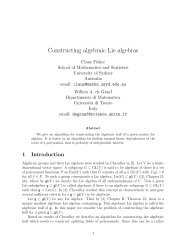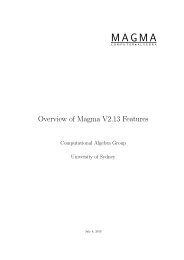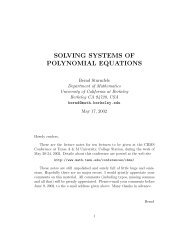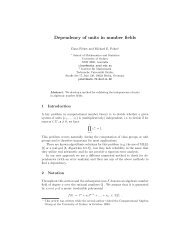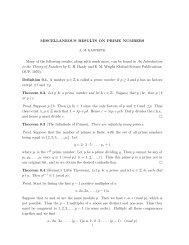Talk in pdf - Magma
Talk in pdf - Magma
Talk in pdf - Magma
Create successful ePaper yourself
Turn your PDF publications into a flip-book with our unique Google optimized e-Paper software.
The New LLL Rout<strong>in</strong>e <strong>in</strong> the<br />
MAGMA Computational<br />
Algebra System<br />
Damien Stehlé<br />
http://www.loria.fr/~stehle<br />
University of Sydney/Université Nancy 1<br />
The New LLL Rout<strong>in</strong>e <strong>in</strong> the MAGMA Computational Algebra System – p. 1
Plan of the <strong>Talk</strong><br />
Rem<strong>in</strong>ders on the LLL algorithm.<br />
How to use the new MAGMA LLL.<br />
NTL versus MAGMA.<br />
Further improvements.<br />
The New LLL Rout<strong>in</strong>e <strong>in</strong> the MAGMA Computational Algebra System – p. 2
Quick bibliography<br />
Lenstra-Lenstra-Lovász ’82.<br />
Schnorr-Euchner ’94.<br />
Nguy ˜ ên-Stehlé ’05.<br />
Nguy ˜ ên-Stehlé ’06.<br />
The New LLL Rout<strong>in</strong>e <strong>in</strong> the MAGMA Computational Algebra System – p. 3
1) Rem<strong>in</strong>ders on lattices<br />
The New LLL Rout<strong>in</strong>e <strong>in</strong> the MAGMA Computational Algebra System – p. 4
Lattices are useful <strong>in</strong> many areas<br />
Computer algebra.<br />
Algorithmic number theory.<br />
Computational group theory.<br />
L<strong>in</strong>ear <strong>in</strong>tegral relation detection.<br />
Cryptanalysis.<br />
Computer arithmetic.<br />
The New LLL Rout<strong>in</strong>e <strong>in</strong> the MAGMA Computational Algebra System – p. 5
Euclidean lattices<br />
Lattice = discrete subgroup of Rn .<br />
d L[bi] = i=1 xibi,xi<br />
<br />
∈ Z ,<br />
represented by a d × n matrix.<br />
If the bi’s are l<strong>in</strong>early <strong>in</strong>dependent, they are a<br />
lattice basis.<br />
Dimension: shared card<strong>in</strong>ality of the bases.<br />
First m<strong>in</strong>imum: λ(L) = m<strong>in</strong>(b : b ∈ L\{0}).<br />
In this talk, d = n and L ⊂ Z d .<br />
The New LLL Rout<strong>in</strong>e <strong>in</strong> the MAGMA Computational Algebra System – p. 6
Gram-Schmidt orthogonalisation<br />
b ∗ 1 = b1, b ∗ i = bi − i−1<br />
j=1 µi,jb ∗ j , µi,j = 〈bi,b ∗ j 〉<br />
b ∗ j 2 .<br />
detL[bi] = b∗ i is <strong>in</strong>dependent of the bi’s.<br />
b1<br />
b ∗ 3<br />
b2<br />
b ∗ 2<br />
b3<br />
The New LLL Rout<strong>in</strong>e <strong>in</strong> the MAGMA Computational Algebra System – p. 7
Two ma<strong>in</strong> computational tasks<br />
Given a basis of a d-dimensional lattice L,<br />
compute a vector b1 ∈ L which is:<br />
not very long as regard to λ(L).<br />
not very long as regard to det(L) 1/d .<br />
The New LLL Rout<strong>in</strong>e <strong>in</strong> the MAGMA Computational Algebra System – p. 8
LLL reduction<br />
A basis (b1,...,bd) is (δ,η)-LLL-reduced if:<br />
(1) ∀i > j, |µi,j| ≤ η.<br />
(2) ∀i, δ · b ∗ i−1 ≤ b∗ i + µi,i−1b ∗ i−1 ,<br />
where δ ∈ (0.25, 1) and η ∈ (0.5, √ δ).<br />
(2) means: <strong>in</strong> (b1,...,bi−2) ⊥ , bi−1 is approx.<br />
shorter than bi.<br />
Often (δ,η) = (0.999, 0.501).<br />
The New LLL Rout<strong>in</strong>e <strong>in</strong> the MAGMA Computational Algebra System – p. 9
Properties of LLL-reduced bases<br />
b1 ≤ δ − η 2 −(d−1)/4 · (det L) 1/d ,<br />
b1 ≤ (δ − η 2 ) −(d−1)/2 · λ(L),<br />
d<br />
i=1 bi ≤ (δ − η 2 ) −d(d−1)/4 · (detL),<br />
∀j < i, b ∗ j ≤ (δ − η2 ) (j−i)/2 · b ∗ i .<br />
The New LLL Rout<strong>in</strong>e <strong>in</strong> the MAGMA Computational Algebra System – p. 10
The rational LLL algorithm<br />
Input: (b1,...,bd) l<strong>in</strong>early <strong>in</strong>dependent.<br />
Output: A LLL-reduced basis of L[bi].<br />
1.κ := 2. While κ ≤ d, do:<br />
2. Make all the |µκ,i|’s smaller than η:<br />
3. Compute the µκ,i’s.<br />
4. For i from κ − 1 down to 1 do, if |µκ,i| ≥ η:<br />
5. bκ := bκ − ⌊µκ,i⌉bi.<br />
6. For j from 1 to i do µκ,j := µκ,j − ⌊µκ,i⌉µi,j.<br />
7. If δb ∗ κ−1 ≤ b ∗ κ + µκ,κ−1b ∗ κ−1, then κ := κ + 1.<br />
8. Else swap bκ−1 and bκ, κ := max(κ − 1, 2).<br />
The New LLL Rout<strong>in</strong>e <strong>in</strong> the MAGMA Computational Algebra System – p. 11
The float<strong>in</strong>g-po<strong>in</strong>t LLL<br />
Classical LLL: Gram-Schmidt computations<br />
done with rational numbers with huge<br />
numerators and denom<strong>in</strong>ators.<br />
fp-LLL: Gram-Schmidt computations done<br />
with float<strong>in</strong>g-po<strong>in</strong>t approximations with much<br />
smaller mantissas.<br />
To get a provable fp-LLL, one needs arbitrary<br />
precision fp numbers and the Gram matrix of<br />
the basis [Stehlé-Nguy ˜ ên ’05].<br />
The New LLL Rout<strong>in</strong>e <strong>in</strong> the MAGMA Computational Algebra System – p. 12
LLL implementations<br />
Fast LLL implementations rely on float<strong>in</strong>g-po<strong>in</strong>t<br />
computations, based on [Schnorr-Euchner ’94].<br />
NTL.<br />
MAGMA.<br />
Pari GP.<br />
LiDIA.<br />
Maple, Mathematica, Gap.<br />
The New LLL Rout<strong>in</strong>e <strong>in</strong> the MAGMA Computational Algebra System – p. 13
2) The new LLL rout<strong>in</strong>e of<br />
MAGMA<br />
The New LLL Rout<strong>in</strong>e <strong>in</strong> the MAGMA Computational Algebra System – p. 14
Ma<strong>in</strong> properties<br />
Correctness.<br />
Term<strong>in</strong>ation.<br />
Reasonably fast<br />
(<strong>in</strong> particular with the Fast option).<br />
Works for l<strong>in</strong>early dependent vectors and<br />
all symmetric matrices.<br />
The New LLL Rout<strong>in</strong>e <strong>in</strong> the MAGMA Computational Algebra System – p. 15
Correctness<br />
When Proof is true, the output basis is<br />
(δ,η)-LLL-reduced.<br />
MAGMA conta<strong>in</strong>s the only guaranteed fp-LLL.<br />
Internally, δ and η are strengthened.<br />
The output is not sorted by length anymore.<br />
To obta<strong>in</strong> better tim<strong>in</strong>gs than before, set Proof to<br />
false, or use LatticeReduce.<br />
The New LLL Rout<strong>in</strong>e <strong>in</strong> the MAGMA Computational Algebra System – p. 16
Ma<strong>in</strong> options<br />
Warn<strong>in</strong>g:<br />
the default variant is seldom the one you want.<br />
LLL parameters δ and η (default: 0.75, 0.501).<br />
SwapCondition. Siegel’s condition:<br />
b ∗ i+1 2 ≥ (δ − η 2 ) · b ∗ i 2 .<br />
EarlyReduction. Vectors can be<br />
size-reduced <strong>in</strong> advance.<br />
Fast. The above parameters are chosen<br />
automatically for you.<br />
The New LLL Rout<strong>in</strong>e <strong>in</strong> the MAGMA Computational Algebra System – p. 17
You want a LLL-reduced basis<br />
Keep the default variant.<br />
Eventually set (δ,η) closer to (1, 1/2).<br />
Eventually set Proof to false.<br />
The New LLL Rout<strong>in</strong>e <strong>in</strong> the MAGMA Computational Algebra System – p. 18
You want the ma<strong>in</strong> LLL properties<br />
Set SwapCondition to Siegel.<br />
Eventually set EarlyReduction to true.<br />
Eventually set Proof to false.<br />
The New LLL Rout<strong>in</strong>e <strong>in</strong> the MAGMA Computational Algebra System – p. 19
You want a somehow reduced basis<br />
Set Proof to false.<br />
Activate the Fast option.<br />
It will output a LLL-reduced basis for some<br />
factors δ,η.<br />
These factors will be given to you.<br />
The New LLL Rout<strong>in</strong>e <strong>in</strong> the MAGMA Computational Algebra System – p. 20
3) Comparison of diverse<br />
LLLs<br />
The New LLL Rout<strong>in</strong>e <strong>in</strong> the MAGMA Computational Algebra System – p. 21
Compared software<br />
MAGMA 2.12 and 2.13, NTL 5.4.<br />
On a 2.4 GHz AMD Opteron.<br />
Us<strong>in</strong>g GNU MP 4.2.1 and Gaudry’s patch,<br />
for both NTL and MAGMA.<br />
Us<strong>in</strong>g MPFR 2.2.0 for MAGMA.<br />
All tim<strong>in</strong>gs <strong>in</strong> seconds.<br />
δ = 0.75,η = 0.501.<br />
The New LLL Rout<strong>in</strong>e <strong>in</strong> the MAGMA Computational Algebra System – p. 22
Term<strong>in</strong>ation test <strong>in</strong> dimension 3<br />
⎡<br />
⎢<br />
⎣<br />
1 −1 0<br />
2 100 + 1 2 100 − 1 0<br />
2 100 2 100 − 1 1<br />
NTL’s G_LLL_FP loops forever.<br />
⎤<br />
⎥<br />
⎦ .<br />
MAGMA 2.12’s LLL without UseGram and<br />
UnderflowCheck: falls down to <strong>in</strong>tegral<br />
method.<br />
PARI: <strong>in</strong>correct answer (2 weeks ago).<br />
The New LLL Rout<strong>in</strong>e <strong>in</strong> the MAGMA Computational Algebra System – p. 23
Term<strong>in</strong>ation test <strong>in</strong> dimension 55<br />
Worst-case for the correctness proof of<br />
[Nguy ˜ ên-Stehlé ’05].<br />
NTL’s LLL_FP and LLL_XD loop forever.<br />
MAGMA 2.12’s LLL without UseGram:<br />
falls down to <strong>in</strong>tegral method. 3.43s.<br />
PARI: 2.67s.<br />
MAGMA 2.13’s LLL: 0.014s.<br />
The New LLL Rout<strong>in</strong>e <strong>in</strong> the MAGMA Computational Algebra System – p. 24
Uniform entries <strong>in</strong> dimension 1000<br />
All entries uniformly chosen with log B bits.<br />
log B NTL MAGMA 2.12 MAGMA 2.13<br />
10 5.43 6.03 5.49<br />
1000 204 46.8 13.2<br />
Pari: > 8000s for the first matrix.<br />
The New LLL Rout<strong>in</strong>e <strong>in</strong> the MAGMA Computational Algebra System – p. 25
Knapsack-type bases<br />
Non trivial entries are log B bit long.<br />
d log B NTL V2.12 V2.13 V2.13 Fast<br />
10 100, 000 37.6 6.69 5.16 2.99<br />
100 10, 000 344 269 134 42.1<br />
150 5, 000 ∞ 1 , 3240 4993 597 250<br />
1 NTL’s LLL_XD loops forever: ⇒ LLL_RR.<br />
The New LLL Rout<strong>in</strong>e <strong>in</strong> the MAGMA Computational Algebra System – p. 26
Simult. Diophant<strong>in</strong>e approximation<br />
Dimension 76, non-trivial entries of ≈ 5000 bits.<br />
NTL V2.12 V2.13 V2.13 Fast<br />
1142 ∞? 76.5 42.8<br />
The New LLL Rout<strong>in</strong>e <strong>in</strong> the MAGMA Computational Algebra System – p. 27
4) Further improvements<br />
The New LLL Rout<strong>in</strong>e <strong>in</strong> the MAGMA Computational Algebra System – p. 28
Possible improvements for LLL<br />
Givens and Householder orthogonalisations?<br />
Provable variant without the Gram matrix.<br />
Technical difficulty: comput<strong>in</strong>g a portion of<br />
the product of two <strong>in</strong>tegers.<br />
Low-level improvement of the <strong>in</strong>teger<br />
operation “big + small × big”.<br />
The New LLL Rout<strong>in</strong>e <strong>in</strong> the MAGMA Computational Algebra System – p. 29
Other LLL-related rout<strong>in</strong>es<br />
PowerRelations and IntegerRelations.<br />
Coppersmith’s method for the small roots of<br />
polynomials (the modular univariate case is<br />
already available).<br />
Schnorr’s block-Kork<strong>in</strong>e-Zolotarev algorithm.<br />
The New LLL Rout<strong>in</strong>e <strong>in</strong> the MAGMA Computational Algebra System – p. 30


